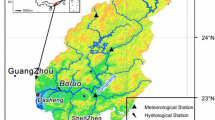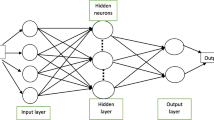Abstract
Estimating salinity concentrations in coastal waters allows characterization of the spatial and temporal dynamics of the freshwater/saltwater interface. In Southeast Florida (USA) the saltwater interface is monitored and evaluated for potential impacts to public supply wellfields and biological communities. In this research, a closed-loop autoregressive neural network with exogenous inputs was developed to estimate salinity concentrations at a coastal water quality station (BISCC4) in Biscayne Bay, Florida. The neural network (ANN) is shown to successfully simulate hourly salinity concentrations for years 2015 through 2019. A statistical comparison of simulated concentrations versus observed data demonstrates that the ANN simulates salinity concentration values and trends within acceptable margin of errors (R2 = 0.59, K-G = 0.64, NSE = 0.33, d = 0.86, PBIAS = 1.5%, RSR = 0.82). In its current form, the ANN model performs better in simulating salinity concentrations and trends, than an existing hydrodynamic model. These results have the potential to be applied to other coastal locations in Biscayne Bay where freshwater inputs from inland streams and canals are affecting salinity concentrations.
Access this chapter
Tax calculation will be finalised at checkout
Purchases are for personal use only
Similar content being viewed by others
References
Conrads, P.A., Darby, L.S.: Development of a coastal drought index using salinity data. Bull. Am. Meteor. Soc. 98, 753–766 (2017). https://doi.org/10.1175/BAMS-D-15-00171.1
Conrads, P.A., Roehl Jr., E.A.: Analysis of salinity intrusion in the Waccamaw River and the Atlantic Intracoastal Waterway near Myrtle Beach, South Carolina, 1995–2002. USGS Scientific Investigations Rep. 2007–5110, 41 pp (2007)
Shaw, J E., Zamorano, M.: Saltwater Interface Monitoring and Mapping Program. Water Resources Division, South Florida Water Management District (2020). https://www.sfwmd.gov/sites/default/files/documents/ws-58_swi_mapping_report_final.pdf
Abiy, A.Z., Melesse, A.M., Abtew, W., Whitman, D.: Rainfall trend and variability in Southeast Florida: Implications for freshwater availability in the Everglades. PLoS ONE 14(2), e0212008 (2019). https://doi.org/10.1371/journal.pone.0212008
Stalker, J., Price, R., Swart, P.: Determining spatial and temporal inputs of freshwater, including submarine groundwater discharge, to a subtropical estuary using geochemical tracers, Biscayne Bay. South Florida. Estuaries and Coasts 32, 694–708 (2009). https://doi.org/10.1007/s12237-009-9155-y
Lorenz, J.J.: A review of the effects of altered hydrology and salinity on vertebrate fauna and their habitats in Northeastern Florida Bay. Wetlands 34(1), 189–200 (2013). https://doi.org/10.1007/s13157-013-0377-1
Alarcon, V.J., Linhoss, A., Kelble, C., Sanchez, G., Mardonez, F., et al.: Tidally forced saltwater intrusion into the Coral Gables Canal. Florida, USA (2021). (In process)
Alarcon, V.J.: Hindcasting and forecasting total suspended sediment concentrations using a NARX neural network. Sustainability 13, 363 (2021). https://doi.org/10.3390/su13010363
Afan, H.A., El-Shafie, A., Mohtar, W.H.M.W., Yaseen, Z.M.: Past, present and prospect of an Artificial Intelligence (AI) based model for sediment transport prediction. J. Hydrol. 541, 902–913 (2016). https://doi.org/10.1016/j.jhydrol.2016.07.048
Shahid, E.S., Salari, M., Rastegar, M., Sheibani, S.N., Ehteshami, M.: Artificial neural network and mathematical approach for estimation of surface water quality parameters (Case study: California, USA). Desalin. Water Treat. 213, 75–83 (2021). https://doi.org/10.5004/dwt.2021.26709
Lin, K., Lu, P., Xu, C.-Y., Yu, X., Lan, T., Chen, X.: Modeling saltwater intrusion using an integrated Bayesian model averaging method in the Pearl River Delta. J. Hydroinf. 21(6), 1147–1162 (2021). https://doi.org/10.2166/hydro.2019.073
Zhou, F., Liu, B., Duan, K.: Coupling wavelet transform and artificial neural network for forecasting estuarine salinity. J. Hydrol. 588, art. no. 125127 (2020). https://doi.org/10.1016/j.jhydrol.2020.125127
Rath, J.S., Hutton, P.H., Chen, L., Roy, S.B.: A hybrid empirical-Bayesian artificial neural network model of salinity in the San Francisco Bay-Delta estuary. Environ. Model. Softw. 93, 193–208 (2017). https://doi.org/10.1016/j.envsoft.2017.03.022
Caccia, V., Boyer, J.: Spatial patterning of water quality in Biscayne Bay, Florida as a function of land use and water management. Mar. Pollut. Bull. 50, 1416–1429 (2005). https://doi.org/10.1016/j.marpolbul.2005.08.002
USGS.: Changing Salinity Patterns in Biscayne Bay, Florida. Prepared in cooperation with South Florida Water Management District and Biscayne National Park (2004). https://doi.org/10.3133/fs20043108
Boussaada, Z., Curea, O., Remaci, A., Camblong, H., Mrabet, N.B.: A Nonlinear Autoregressive Exogenous (NARX) Neural network model for the prediction of the daily direct solar radiation. Energies 11, 620 (2018). https://doi.org/10.3390/en11030620
Moriasi, D.N., Arnold, J.G., Van Liew, M.W., Bingner, R.L., Harmel, R.D., Veith, T.L.: Model evaluation guidelines for systematic quantification of accuracy in watershed simulations. Trans. ASABE 50, 885–900 (2007). https://doi.org/10.13031/2013.23153
Ang, R., Oeurng, C.: Simulating streamflow in an ungauged catchment of Tonlesap Lake Basin in Cambodia using Soil and Water Assessment Tool (SWAT) model. Water Sci. 32, 89–101 (2018). https://doi.org/10.1016/j.wsj.2017.12.002
Knoben, W.J.M., Freer, J.E., Woods, R.A.: Technical note: Inherent benchmark or not? Comparing Nash-Sutcliffe and Kling-Gupta efficiency scores. Hydrol. Earth Syst. Sci. 23, 4323–4331 (2019). https://doi.org/10.5194/hess-23-4323-2019
Hussein, A.A.: Derivation and comparison of open-loop and closed-loop neural network battery state-of-charge estimators. Energy Procedia 75, 1856–1861 (2015). https://doi.org/10.1016/j.egypro.2015.07.163
Author information
Authors and Affiliations
Corresponding author
Editor information
Editors and Affiliations
Rights and permissions
Copyright information
© 2021 Springer Nature Switzerland AG
About this paper
Cite this paper
Alarcon, V.J., Linhoss, A.C., Kelble, C.R., Mickle, P.F., Bishop, J., Milton, E. (2021). Estimation of Hourly Salinity Concentrations Using an Artificial Neural Network. In: Gervasi, O., et al. Computational Science and Its Applications – ICCSA 2021. ICCSA 2021. Lecture Notes in Computer Science(), vol 12954. Springer, Cham. https://doi.org/10.1007/978-3-030-86979-3_44
Download citation
DOI: https://doi.org/10.1007/978-3-030-86979-3_44
Published:
Publisher Name: Springer, Cham
Print ISBN: 978-3-030-86978-6
Online ISBN: 978-3-030-86979-3
eBook Packages: Computer ScienceComputer Science (R0)




